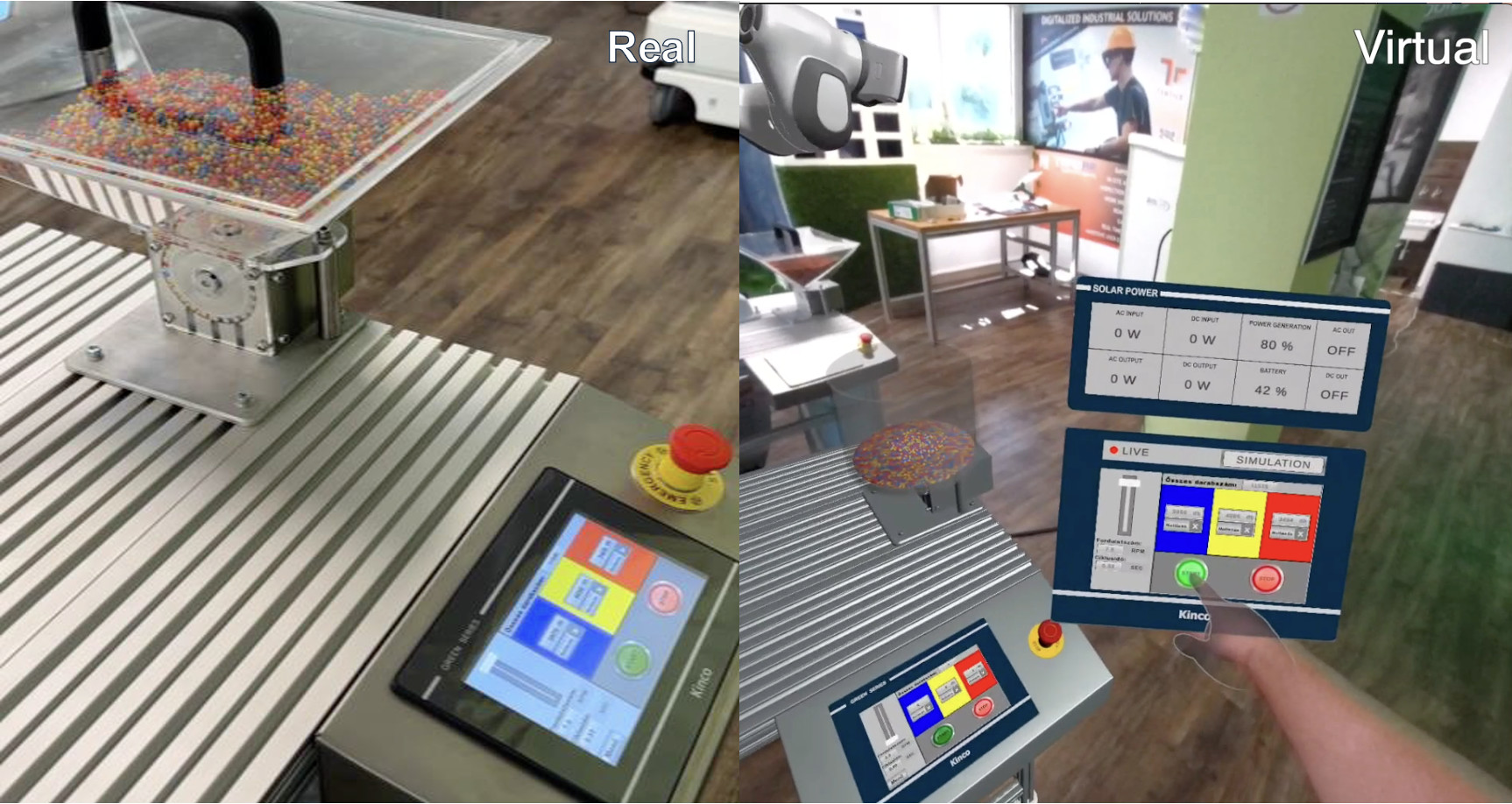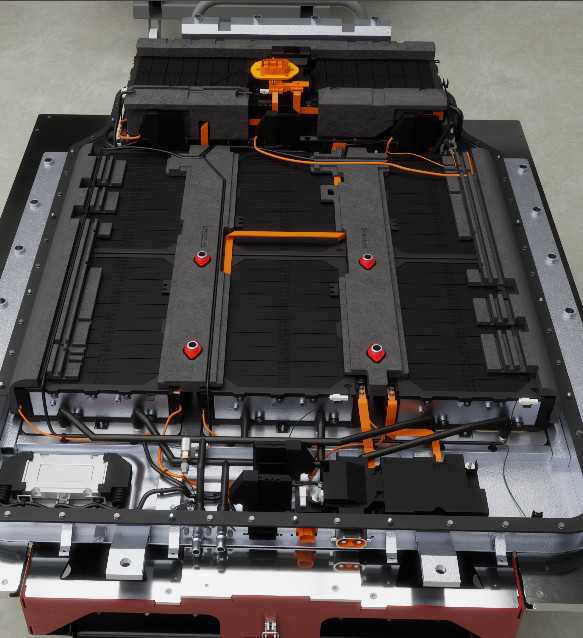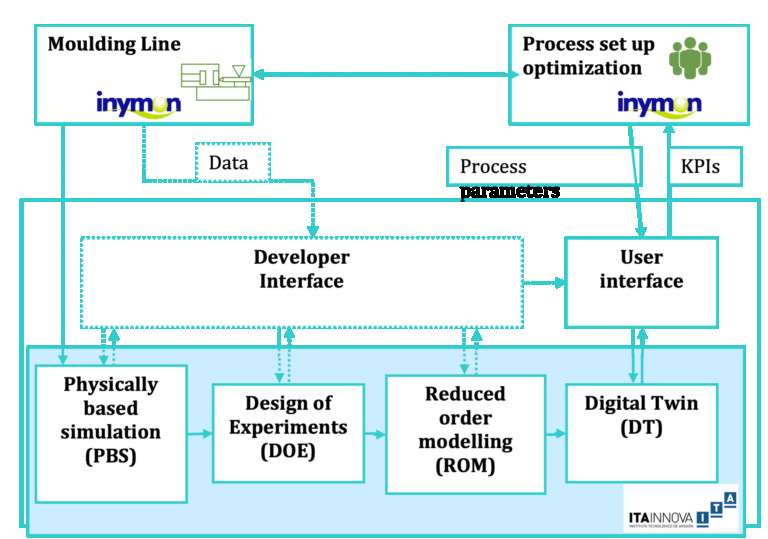The SMC FIC-400 Teaching Learning Factory (TLF), part of PBN’s Digital Innovation Hub in Hungary, has integrated an innovative Digital Twin of its new recycling module, under the DigiTwinGreen project funded by the EIT Regional Innovation Scheme. The Digital Twin simulates the recycling process in a Mixed-Reality environment, allowing for hands-on training and optimization of the recycling module's efficiency.
The SMC FIC-400 Teaching Learning Factory (TLF), located in PBN’s Digital Innovation Hub in Hungary, offers the opportunity to design, develop, and test successfully working solutions for the industry. The TLF is a critical component of a 15-module system including 5 Industry 4.0 modules. This assembly line system features a pallet and container feeder, pellet feeder, cupping station, warehouse, as well as a labelling and dispatching station. These are all connected to a Manufacturing Engineering System, capable of managing orders, initiating manufacturing process, monitoring warehouse state, etc.
As part of the DigiTwinGreen project, funded under the EIT Regional Innovation Scheme, the TLF has been extended with a new recycling module capable of sorting balls of different colour. Specifically, balls from the container disk fall into the nests of a rotating dosing disc, where a sensor identifies the colour of the balls triggering the corresponding latch to open. Subsequently, the balls are delivered to the appropriate container by pipes that continue beneath the worktable. The recycling module also includes a dedicated User Interface (UI), featuring a slider to set the speed of the disk (in RPM), start/stop buttons and a numeric display which displays the current speed value (RPM), the cycle time and the number of sorted pieces (per colour and total number).
Under this context, a Digital Twin simulation environment for the recycling module has been developed to enable the digital representation and operation of the recycling procedure. For the visualisation and control of the virtual twin module, a Mixed-Reality (MR) approach has been employed to blend the real and virtual aspects of the module and facilitate their interaction in semi real-time. In this way, the Digital Twin can provide hands-on training to new workers, enabling them to learn the manufacturing process and gain practical knowledge quickly and efficiently. The MR technology has been implemented through the Oculus Quest Pro headset, while the developed application carried out in Unity 3D software. The whole solution was deployed at the edge. For the seamless accommodation of the virtualization and simulation task’s demands, a powerful workstation has been utilised, encapsulating processing power for both CPU and GPU, as well as meeting the essential memory requirements for deploying MR applications.
Furthermore, to ensure the green modality of the recycling module, a solar panel was utilised to supply the energy along with storage unit to store the energy produced. Through the simulation environment the process efficiency of the module was enhanced by identifying the theoretical optimal rotational speed (RPM) of the rotating disk which maximizes the throughput (pieces/time) of the module. Finally, CORE Innovation Centre has verified that the Digital Twin’s features comply with the user requirements, and the Digital Twin’s accuracy has been validated by data-driven techniques, proving that it is capable of accurately replicating the operational behaviour of the real-world recycling module.
<p class="MsoNormal" style="margin: 0cm; text-align: justify; font-size: 11pt; font-family: Aptos, sans-serif;"><a href="https://digitwingreen.eu/" target="_blank">https://digitwingreen.eu/</a><a href="https://digitwingreen.eu/" target="_blank"></a></p><p class="MsoNormal" style="margin: 0cm; text-align: justify; font-size: 11pt; font-family: Aptos, sans-serif;"><br></p><p class="MsoNormal" style="margin: 0cm; text-align: justify;"><a href="https://www.pbn.hu/" target="_blank">https://www.pbn.hu/</a><font face="Aptos, sans-serif"><span style="font-size: 14.6667px;"> </span></font></p><p class="MsoNormal" style="margin: 0cm; text-align: justify;"><font face="Aptos, sans-serif"><span style="font-size: 14.6667px;"><br></span></font></p><p class="MsoNormal" style="margin: 0cm; text-align: justify;"><font face="Aptos, sans-serif"><span style="font-size: 14.6667px;"><br></span></font><br></p><p class="MsoNormal" style="margin: 0cm; text-align: justify;"><font face="Aptos, sans-serif"><span style="font-size: 14.6667px;"><br></span></font></p><p class="MsoNormal" style="margin: 0cm; text-align: justify;"><font face="Aptos, sans-serif"><span style="font-size: 14.6667px;"><br></span></font><br></p><p class="MsoNormal" style="margin: 0cm; text-align: justify; font-size: 11pt; font-family: Aptos, sans-serif;"><span lang="EN-US"><o:p></o:p></span></p>










